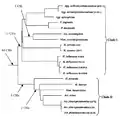Conserved Signature Indel
Conserved signature inserts and deletions (zu Deutsch ‚konservierte charakteristische Indels‘, CSI) sind Indels in konservierten proteincodierenden DNA-Sequenzen. Sie werden in der Biochemie und Genetik als Marker zur Bestimmung von Verwandtschaftsgraden zwischen verschiedenen Arten verwendet.[1][2]

Eigenschaften
CSI gehören zu den Indels und treten im Vergleich zu SNP selten auf. Die CSI unterscheiden sich nur wenig zwischen zwei Arten und fast nicht innerhalb einer Art. Daher können sie zur Bestimmung der Verwandtschaft unterschiedlicher Arten und zur Erstellung eines phylogenetischen Baums verwendet werden.[2][3][4][5] Alternativ zur Stammbaumanalyse per CSI werden meistens die SNP der 16S rRNA verglichen.[6][7][8][9][10]
Gruppenspezifische CSI
Manche CSI sind gruppenspezifisch und sind charakteristisch für das betreffende Taxon, da sie in allen Vertretern einer Gruppe und nicht in anderen Gruppen auftreten. Das ursprüngliche Indel eines taxonspezifischen CSI trat vermutlich bereits vor der Aufspaltung im letzten gemeinsamen Vorfahren auf.[2][5]
Multigruppen- oder Hauptlinien-CSI

Multigruppen-CSI (synonym Hauptlinien-CSI) sind CSI, die in mehreren Phyla vorkommen, nicht jedoch in einzelnen Phyla.[2] Hierzu gehören z. B. ein CSI von 150–180 Aminosäuren in der Gyrase B an der Position 529–751, das in verschiedenen Proteobacteria, Chlamydiaceae, Planctomycetes und Aquificales vorkommt, jedoch nicht in anderen bakteriellen Phyla oder Archaeen.[11] Ein weiteres Hauptlinien-CSI von etwa 100 Aminosäuren ist im Protein RpoB an der Position 919–1058 und kommt in Proteobacteria, Bacteroidetes-Chlorobi, Chlamydiaceae, Planctomycetes und Aquificales vor.[12][13][14] Bei Wirbeltieren gibt es ein CSI in dem Protein Bcl2l10.[15]
Anwendungen
 CSI-basierte Verwandtschaftsverhältnisse innerhalb der Thermotogae
CSI-basierte Verwandtschaftsverhältnisse innerhalb der Thermotogae CSI-basierte Verwandtschaftsverhältnisse zweier Phyla der Archaeen
CSI-basierte Verwandtschaftsverhältnisse zweier Phyla der Archaeen CSI-basierte Verwandtschaftsverhältnisse innerhalb der Pasteurellen
CSI-basierte Verwandtschaftsverhältnisse innerhalb der Pasteurellen
CSI wurden unter anderem zur Abgrenzung der Gattung Thermotogae von anderen Bakterien und der einzelnen Stämme voneinander eingesetzt.[16]
Einzelnachweise
- S. L. Baldauf: Animals and Fungi are Each Other's Closest Relatives: Congruent Evidence from Multiple Proteins. In: Proceedings of the National Academy of Sciences. 90, Nr. 24, 1993. doi:10.1073/pnas.90.24.11558. PMID 8265589. PMC 48023 (freier Volltext).
- Radhey S. Gupta: Protein Phylogenies and Signature Sequences: A Reappraisal of Evolutionary Relationships among Archaebacteria, Eubacteria, and Eukaryotes. In: Microbiology and Molecular Biology Reviews. 62, Nr. 4, 1998, S. 1435–91. PMID 9841678. PMC 98952 (freier Volltext).
- Radhey S. Gupta, Emma Griffiths: Critical Issues in Bacterial Phylogeny. In: Theoretical Population Biology. 61, Nr. 4, 2002, S. 423–34. doi:10.1006/tpbi.2002.1589. PMID 12167362.
- Ania M. Cutiño-Jiménez, Marinalva Martins-Pinheiro, Wanessa C. Lima, Alexander Martín-Tornet, Osleidys G. Morales, Carlos F.M. Menck: Evolutionary placement of Xanthomonadales based on conserved protein signature sequences. In: Molecular Phylogenetics and Evolution. 54, Nr. 2, 2010, S. 524–34. doi:10.1016/j.ympev.2009.09.026. PMID 19786109.
- Antonis Rokas, Peter W.H. Holland: Rare genomic changes as a tool for phylogenetics. In: Trends in Ecology & Evolution. 15, Nr. 11, 2000. doi:10.1016/S0169-5347(00)01967-4. PMID 11050348.
- James R. Brown, Christophe J. Douady, Michael J. Italia, William E. Marshall, Michael J. Stanhope: Universal trees based on large combined protein sequence data sets. In: Nature Genetics. 28, Nr. 3, 2001, S. 281–5. doi:10.1038/90129. PMID 11431701.
- T Cavalier-Smith: The neomuran origin of archaebacteria, the negibacterial root of the universal tree and bacterial megaclassification. In: International Journal of Systematic and Evolutionary Microbiology. 52, Nr. 1, 2002, S. 7–76. PMID 11837318.
- F. D. Ciccarelli, T Doerks, C Von Mering, CJ Creevey, B Snel, P Bork: Toward Automatic Reconstruction of a Highly Resolved Tree of Life. In: Science. 311, Nr. 5765, 2006, S. 1283–7. doi:10.1126/science.1123061. PMID 16513982.
- V. Daubin, M Gouy, G Perrière: A Phylogenomic Approach to Bacterial Phylogeny: Evidence of a Core of Genes Sharing a Common History. In: Genome Research. 12, Nr. 7, 2002, S. 1080–90. doi:10.1101/gr.187002. PMID 12097345. PMC 186629 (freier Volltext).
- Jonathan A. Eisen: The RecA Protein as a Model Molecule for Molecular Systematic Studies of Bacteria: Comparison of Trees of RecAs and 16S rRNAs from the Same Species. In: Journal of Molecular Evolution. 41, Nr. 6, 1995, S. 1105–23. doi:10.1007/bf00173192. PMID 8587109. PMC 3188426 (freier Volltext).
- E. Griffiths, R. S. Gupta: Phylogeny and shared conserved inserts in proteins provide evidence that Verrucomicrobia are the closest known free-living relatives of chlamydiae. In: Microbiology. 153, Nr. 8, 2007. doi:10.1099/mic.0.2007/009118-0. PMID 17660429.
- Radhey S. Gupta: Evolutionary relationships among photosynthetic bacteria. In: Photosynthesis Research. 76, Nr. 1–3, 2003, S. 173–83. doi:10.1023/A:1024999314839. PMID 16228576.
- Emma Griffiths, Radhey S. Gupta: Signature sequences in diverse proteins provide evidence for the late divergence of the Order Aquificales. In: International Microbiology. 7, Nr. 1, 2004, S. 41–52. PMID 15179606.
- V. Gaget, S. Gribaldo, N. Tandeau de Marsac: An rpoB signature sequence provides unique resolution for the molecular typing of cyanobacteria. In: International journal of systematic and evolutionary microbiology. Band 61, Pt 1 Januar 2011, S. 170–183, ISSN 1466-5034. doi:10.1099/ijs.0.019018-0. PMID 20190018.
- Y. Guillemin, A. Cornut-Thibaut, G. Gillet, F. Penin, A. Aouacheria: Characterization of unique signature sequences in the divergent maternal protein Bcl2l10. In: Molecular biology and evolution. Band 28, Nummer 12, Dezember 2011, S. 3271–3283, ISSN 1537-1719. doi:10.1093/molbev/msr152. PMID 21705382.
- Radhey S. Gupta, Vaibhav Bhandari: Phylogeny and molecular signatures for the phylum Thermotogae and its subgroups. In: Antonie van Leeuwenhoek. 100, Nr. 1, 2011, S. 1–34. doi:10.1007/s10482-011-9576-z. PMID 21503713.